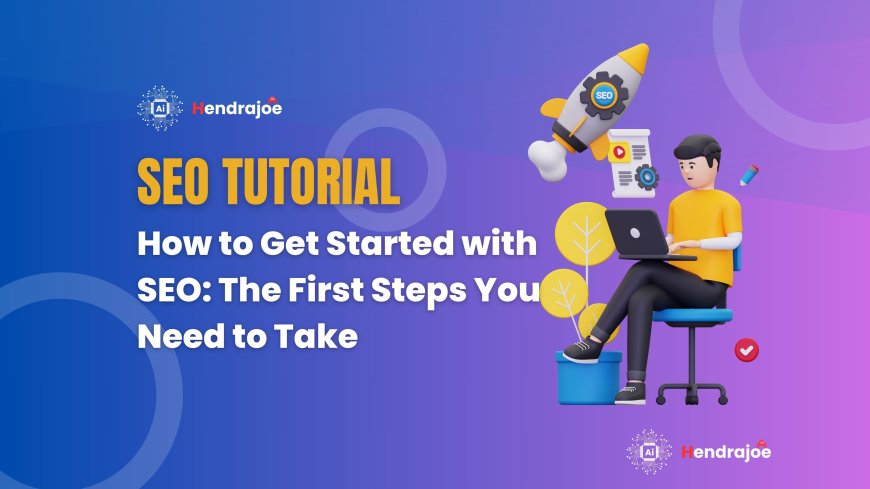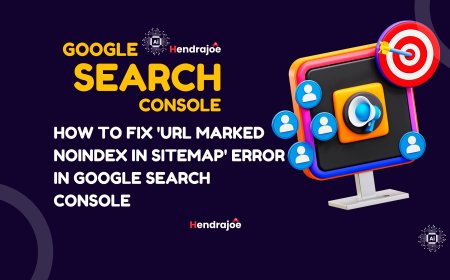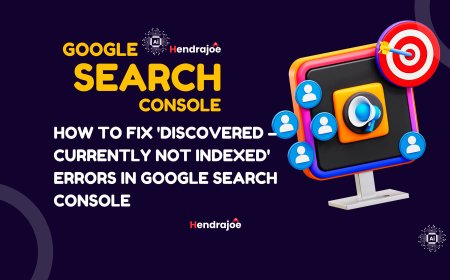How to Get Started with SEO: The First Steps You Need to Take
Learn how to get started with SEO with these essential first steps. This guide will help you understand SEO basics, set goals, optimize your website, and track your progress

Search Engine Optimization (SEO) can be a game-changer for your website. If you’re new to SEO and aren’t sure where to start, don’t worry. This guide will break down the first steps you need to take to set your website up for success in search engine rankings.
SEO is the process of improving your website so that search engines can easily crawl, index, and rank it. By optimizing your website for search engines, you increase your chances of ranking higher for relevant search terms, which ultimately drives more organic traffic to your site.
SEO may seem complex at first, but once you break it down into manageable steps, it becomes much easier to tackle. This article will guide you through the first crucial steps you should take when starting your SEO journey.
1. Understand the Basics of SEO
Before diving into any technical aspects, it’s important to get a solid understanding of what SEO is and how it works. SEO involves several key components, including on-page SEO (optimizing content and structure), off-page SEO (building backlinks), and technical SEO (optimizing your site’s technical aspects). Understanding these different elements will help you develop a comprehensive strategy for improving your website’s visibility.
Take some time to read beginner-friendly SEO guides, like the ones available from Google’s Webmaster Guidelines or other reputable SEO blogs. This will give you a good foundation for the more advanced strategies you’ll tackle later on.
2. Set Clear SEO Goals
The next step is to set clear SEO goals. Ask yourself what you want to achieve with SEO. Are you trying to increase website traffic, improve your search engine ranking, or convert visitors into customers? By having clear objectives, you can shape your SEO strategy accordingly.
Some examples of SEO goals might include:
- Increasing organic traffic: Targeting specific keywords to drive more visitors to your website.
- Improving rankings for specific keywords: Aiming to rank higher for particular search terms relevant to your niche.
- Increasing conversions: Focusing on optimizing your site’s user experience (UX) to turn visitors into customers, subscribers, or leads.
Once you define your goals, you can tailor your SEO efforts toward achieving those specific outcomes. Setting measurable goals will also help you track your progress and make adjustments along the way.
3. Conduct a Website Audit
Before optimizing your website, it's essential to conduct a thorough audit to understand where your site currently stands in terms of SEO. A website audit will give you a clear picture of your site's performance and highlight areas that need improvement.
You can use SEO tools like Google Search Console, Ahrefs, or SEMrush to analyze various aspects of your site, including:
- Site structure: Is your website easy to navigate? Is the structure logical?
- Page speed: Does your website load quickly? Slow-loading pages can hurt your rankings.
- Mobile-friendliness: Is your website optimized for mobile devices?
- Broken links: Are there any dead links that need to be fixed?
Once you identify any issues during the audit, you can begin to address them and make improvements to your site.
4. Keyword Research: The Foundation of SEO
Keyword research is one of the most important steps in getting started with SEO. Keywords are the terms and phrases people enter into search engines when looking for information. By optimizing your content for the right keywords, you increase the likelihood of ranking higher for relevant searches.
To get started with keyword research:
- Identify your target audience: Think about the words and phrases your target audience might use when searching for your products or services.
- Use keyword research tools: Tools like Google Keyword Planner, Ahrefs, or Ubersuggest can help you find high-traffic keywords related to your niche. Focus on long-tail keywords (longer, more specific phrases) as they often have lower competition and can be easier to rank for.
- Analyze search intent: Understanding the intent behind a search query is crucial. Is the user looking for information, products, or services? Tailor your content to meet their intent.
Once you’ve identified the right keywords, create a list of the ones you want to target. You’ll use these keywords to optimize your content, meta tags, and other aspects of your website.
5. Optimize Your Website’s On-Page SEO
On-page SEO refers to the elements on your website that you can control, such as content, keywords, and HTML tags. Optimizing these elements is critical for improving your site’s visibility in search engine results.
Here’s what you need to do for effective on-page SEO:
Title Tags
Your title tag is the clickable headline that appears in search results. It should clearly describe the content of your page and include your target keyword. Keep your title tags under 60 characters to ensure they display properly in search results.
For example, if you’re optimizing a page about SEO tips for beginners, your title tag might be “SEO Tips for Beginners: A Complete Guide to Getting Started.”
Meta Descriptions
A meta description is a short summary of the page’s content that appears below the title in search results. While meta descriptions don’t directly impact rankings, they influence click-through rates. Write compelling meta descriptions that include your target keywords and encourage users to click.
For example: “Learn how to get started with SEO with these simple, actionable tips. Perfect for beginners looking to improve their website’s search engine rankings.”
Header Tags
Header tags (H1, H2, H3, etc.) help structure your content and make it easier for both users and search engines to read. Your main title should be an H1 tag, and subheadings should be H2 or H3 tags. Use header tags to break up your content into logical sections and make it easier to navigate.
Content Optimization
The content on your page should be informative, engaging, and relevant to your target audience. Be sure to include your target keywords naturally, but avoid keyword stuffing. Write content that answers the questions users are searching for and provides real value.
Internal Linking
Internal links help search engines discover more pages on your site and understand the relationship between your content. Link relevant pages within your site to guide users to other helpful content and improve the overall structure of your site.
6. Improve Website Speed
Website speed is a critical factor in both SEO and user experience. Websites that load slowly can lead to high bounce rates, which negatively impact your rankings. Google even uses site speed as a ranking factor, so improving your page load times is essential for SEO.
To improve website speed, you can:
- Optimize images by compressing them without sacrificing quality.
- Minimize JavaScript and CSS files.
- Enable browser caching to store frequently accessed elements.
- Use a content delivery network (CDN) to speed up content delivery.
You can use tools like Google PageSpeed Insights or GTmetrix to analyze your website’s speed and get suggestions for improvement.
7. Focus on Mobile Optimization
More and more people are browsing the internet on mobile devices, so Google uses mobile-first indexing. This means Google primarily uses the mobile version of your site to determine rankings.
Make sure your website is mobile-friendly by:
- Using a responsive design that automatically adjusts to different screen sizes.
- Ensuring text is large enough to be readable on small screens.
- Optimizing images and other media for mobile viewing.
- Reducing pop-ups that can be intrusive on mobile devices.
8. Start Building Backlinks
Backlinks are links from other websites that point to your content. Search engines view backlinks as a sign of credibility, so the more high-quality backlinks your website has, the better it will rank.
To get started with backlinks:
- Create valuable, shareable content: When other websites see your content as valuable, they are more likely to link to it.
- Guest post: Writing guest posts on relevant blogs can help you gain exposure and build backlinks.
- Reach out: If you find a relevant site that might benefit from your content, reach out and ask them to link to your page.
9. Track Your SEO Progress
Once you've implemented your SEO strategy, it’s essential to track your progress. Use tools like Google Analytics and Google Search Console to monitor your website’s performance, track keyword rankings, and see how your SEO efforts are affecting traffic and conversions.
Regularly check your performance and adjust your strategy based on the data you collect. SEO is an ongoing process, so don’t expect immediate results, but be patient and keep optimizing.
Conclusion
Getting started with SEO may seem daunting, but by taking one step at a time, you can effectively improve your website’s visibility and ranking. Start with a solid understanding of SEO, set clear goals, and conduct a thorough website audit. From there, focus on keyword research, on-page optimization, and improving your website’s speed and mobile-friendliness.
Remember, SEO is a long-term strategy, and success doesn’t happen overnight. But by following these first steps, you’ll be on your way to driving more organic traffic, improving your rankings, and growing your online presence.
What's Your Reaction?









































